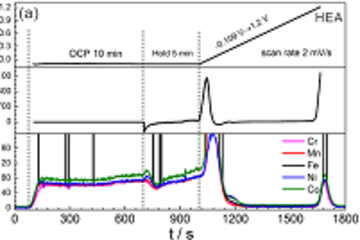All genres
681.
Talk
Tailoring microstructures from amorphous precursors: crystallization and corrosion in Fe-based amorphous alloys. EMN Meeting on Metallic Glasses 2016, Kuala Lumpur, Malaysia (2016)
682.
Talk
Insights into dislocation grain-boundary interaction by X-ray µLaue diffraction. Dislocations 2016, West Lafayette, IN, USA (2016)
683.
Talk
Slip transfer through coherent Sigma 3 (111) twin boundaries loaded in different crystallographic direction: Insights by Laue microdiffraction. Materials Science and Engineering Conference, Highlight Lecture, Darmstadt, Germany (2016)
684.
Talk
Atoms, ions, electrons: simulated, measured and manipulated. Workshop on Scientific Directions for Future Transmission Electron Microscopy, Jülich, Germany (2016)
685.
Talk
Chemo-Mechanics at Lattice Defects: from Mechanisms to Bulk Alloys. Gordon Research Conference on Thin Film & Small Scale Mechanical Behavior, Lewiston, ME, USA (2016)
686.
Talk
Stability of nanocrystalline metals: Cu-Cr as a case study. PICS meeting, Marseilles, France (2016)
687.
Talk
Defect Segregation studied by Correlative Atom Probe Tomography and Electron Microscopy. Japan-Germany Joint Symposium on Advanced Characterization of Nanostructured Materials for Energy and Environment, Conference Center Mutterhaus, Düsseldorf, Germany (2016)
688.
Talk
Deformation and Adhesion of Metallic Thin Films. International Conference on Metallurgical Coatings and Thin Films, 43rd ICMCTF, San Diego, CA, USA (2016)
689.
Talk
Are Mo2BC nanocrystalline coatings damage resistant? Insights from comperative tension experiments. 62. Metallkunde-Kolloquium, Werkstoffforschung für Wirtschaft und Gesellschaft , Lech am Arlberg, Austria (2016)
690.
Talk
Dislocation twin boundary interaction and its dependence on loading direction. 62. Metallkunde-Kolloquium, Lech am Arlberg, Austria (2016)
691.
Talk
Dislocation-grain boundary interaction at the micron scale: Insights by in situ Laue microdiffraction. Jung-DGM-Rhein-Ruhr, Aachen, Germany (2016)
692.
Talk
In-situ TEM isothermal annealing of nanocrystalline supersaturated Cu–Cr thin film alloys. 80th Annual Conference of the DPG and DPG Spring Meeting, Regensburg, Germany (2016)
693.
Talk
X-ray µLaue diffraction to understand plasticity at interfaces. DPG Frühjahrstagung 2016, Regensburg, Germany (2016)
694.
Talk
Slip transfer through coherent Σ3 (111) twin boundaries loaded in different crystallographic directions. DGM Arbeitskreis Treffen „Rasterkraftmikroskopie und nanomechanische Methoden"
, Saarland, Germany (2016)
695.
Talk
Unexpected Stress Induced Martensite Formation in Ultra-strong Pearlitic Steel. 2016 TMS Annual Meeting & Exhibition, Symposium: Advanced Characterization Techniques for Quantifying and Modeling Deformation
, Nashville, TN, USA (2016)
696.
Talk
Micro-scale fracture behavior of Co based metallic glass thin films. 2016 TMS Annual Meeting and Exhibition Symposium: In Operando Nano- and Micro-mechanical Characterization of Materials with Special Emphasis on In Situ Techniques, Nashville, TN, USA (2016)
697.
Talk
Mechanically driven martensite formation in ultra-strong pearlitic steel. Thermec 2016, Graz, Austria (2016)
698.
Talk
Investigation of solid state dewetting phenomena of epitaxial Al thin films on sapphire using electron microscopy. The 16th European Microscopy Congress (EMC 2016), Lyon, France (2016)
699.
Talk
Solid state dewetting of epitaxial Al thin films on sapphire studied by electron microscopy. Materials Research Society Fall Meeting & Exhibition 2016 (MRS Fall 2016), Boston, MA, USA (2016)
700.
Talk
A New Method to Study the Composition Dependence of Mechanical Properties of Laves. MRS Fall Meeting 2016, Boston, MA, USA (2016)











